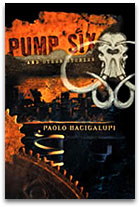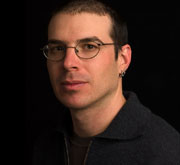
Pump Six and Other Stories, by Paolo Bacigalupi.
Science fiction writer Paolo Bacigalupi, author of the new collection Pump Six and Other Stories, envisions a future filled with environmental terrors. His characters move through worlds transformed by climate change, genetic engineering, drought, and toxic waste — places that seem exotic at first, but on second glance are just a few unwitting steps beyond today’s headlines.
As Bacigalupi’s Colorado neighbor, I’ve watched his work evolve — and watched with interest as he borrowed themes from environmental journalism. So I sat down with him to discuss the complicated relationship between environmental reporting and science fiction. No mention was made of our unpronounceable last names.
We’ve known each other for many years now, and we’ve read each other’s stories as they’ve developed. Many of your stories are based partly on things I’ve reported on as an environmental journalist — drought, climate change, endocrine disruptors — and it’s interesting to see my reporting fictionalized in various frightening ways. So, Paolo, what I really brought you here to ask is this: Why do you keep ripping me off?

Paolo Bacigalupi.
Photo: JT Thomas Photography
[Laughs.] Good question. What environmental journalists do for me, at least, is that they’re a lot like magpies picking at roadkill. You see them up ahead, you see them swirling around, and you know something interesting is coming up. Environmental journalists are unearthing things that we don’t necessarily want to look at, but they’re powerful and important things that we need to know about. So what they report provides almost perfect fodder for stories, mostly because they can only take the stories so far. Environmental journalists point the way toward saying, “The world is changing.” What I can do with science fiction, then, is say, “Well, let’s see how that looks.”
Seeing your work makes me wonder if environmental journalists are actually creating their own limits — that we might be able to go further into the speculative realm than we think.
The speculative process, the process of going two or three steps down the road beyond what you can actually report, oftentimes [gives us] the information we really need to know. And it seems like scientists are inherently conservative, and science journalists are inherently conservative, because you don’t want to be wrong. But that’s where I can get involved as a science fiction writer. I don’ t have to be right, exactly, [but] I need to illustrate. I need to illustrate a feeling or experience so that people can say, “Does that seem like something we want to be going toward?”

Michelle Nijhuis.
Photo: JT Thomas Photography
Can you describe how you did that in one of your stories?
With “The Tamarisk Hunter,” I was doing that with drought. The Colorado River is perennially drought-ridden, but recently, as the Glen Canyon Dam, as Lake Powell, gets lower and lower, we see this trend going on. And at some level we’re aware of it, but we’re not really dealing with that in any concrete way. But you can look at that and say, “Huh, if that dam keeps getting drained, what happens next?” So with a story like “The Tamarisk Hunter,” I create a situation where we really do run out of a lot of water, and where the drought is deep and long-lasting and brutal, and then I start speculating about how human beings will deal with this, and whether or not they’re going to be generous and sharing with their water, or whether they’re going to treat it like a scarce resource and fight over it.
I’ve started to feel like my work is getting ever closer to sci-fi, as the issues we’re dealing with have more potential to really create a new world — a world that’s transformed by drought or by any of the other global issues that we’re now reporting on as environmental journalists. And I think our old formula as journalists, where we targeted [one] problem and unpacked it — for instance, let’s look at how DDT is causing all these problems — I feel like in the face of these global problems, that’s a less and less adequate strategy.
In some ways the problems seem so complex and so large that it’s hard to pull the Rachel Carson [approach of] “Look, here’s the problem, let’s fix it,” both because they’re international problems and because we seem to have lost some of our political will or human interest in these things. So maybe finding other ways to tell those stories so that they’re still interesting, and can engage a public, is science journalism’s next big challenge.
So we’ve been talking about environmental journalism and its formula, but you’ve also broken the sci-fi formula in some ways by connecting us to the problems we’re facing in the real world. Can you talk a little bit about how you do that?
Science fiction, traditionally, is very much a technophilic sort of literature. And I’m much more of a technophobe — I’m not quite a Luddite, but I’m definitely not a techno champion. And sci-fi has always been in that space, thrived in that space of, “Hey, if we’re competent people and we’re smart, we can, by gum, get something done here.” When I look at our problems, many of them are actually techno-problems — we don’t create techno-fixes, we create techno problems. So within the genre I tend to sit as an outlier, because I’m writing mostly about where things went wrong, and where we need to rethink our techno love. That puts me at odds with a lot of what you see in the genre. So even though I’m using the tools of science fiction, I often see myself as an environmental writer.
Yeah, technology in your stories is never really a fix. I’m thinking of a story in this collection called “The People of Sand and Slag” where technology has been created — weeviltech, it’s called — so that people can actually digest mine waste. Which I suppose might be a solution in some ways — [Laughs.]
It’s a perfect solution! It’s a perfect solution!
— but it’s not exactly what we’re looking for.
Technology doesn’t provide wisdom. And when I look at my stories, what I’m really writing about is, “Are we wise? And will we be wise? And how do we be wise?” Mostly those are hard choices. They aren’t quick-and-easy, let’s get another gadget together. And so yeah, with “The People of Sand and Slag,” it’s explicitly saying, “Yes, we can have all the tech we want, and it will not make us wise.”
I find these [Pump Six] stories hopeful in a weird way, because there’s always some sort of hero with a moral core who’s fighting the dominant culture you’ve created. But these are pretty grim worlds — you’re extrapolating the problems we have now to an extreme degree and letting us see what happens. So I wonder if you’ve ever tried creating a utopia.
My natural zone is dystopic. And that’s partly informed by what I read, thanks to you guys writing such depressing stories about what’s happening in the world.
It’s not our fault! We can blame it on reality. You can’t.
Reading a lot of your writing, I have this moment of fear, and that fear is what drives me to write. You guys pick up rocks and look under them and tell us things we don’t want to know about — you have all these creepy-crawlies that you keep discovering. All the work I’ve been doing is to examine those creepy-crawlies. Now I’m starting to think about what to do next. The utopic side of science fiction [is] saying well, wait, maybe there’s a way that we can move toward something more positive.
<!–
–>
Right now all of our myths are focused on how to become rich and successful — we tell stories about ourselves as explorers, as adventurers, as extractors. So I’m wondering about the creation of another set of myths and models, where we start to get excited about the possibility of being a sustainable species rather than a rapacious species.
When I think about that, I think about writing young-adult fiction. I think about writing for kids who can be inspired to develop in different ways than their parents. One of the exciting things about science fiction is that it’s been an inspirational literature for young people — when I grew up it was all about rocket ships, and boy, you sure wanted to be a NASA scientist when you’d read about rocket ships enough. And I wonder if there isn’t some way to write science fiction that says, “Boy, isn’t it cool to be a wind engineer and develop wind turbines,” or “Boy, isn’t it cool to really study species and figure out ways for us to live inside of our niches.”
Looking at this as advice for environmental journalists, who are looking to get at their audiences in a new way, are you saying …
[Laughs.] Give up on the adults! Give up on the adults! I know so few adults that live in a sustainable way right now. But kids still are malleable, kids still have an opportunity to say “Wait, no, I’m going to live a different way.”


